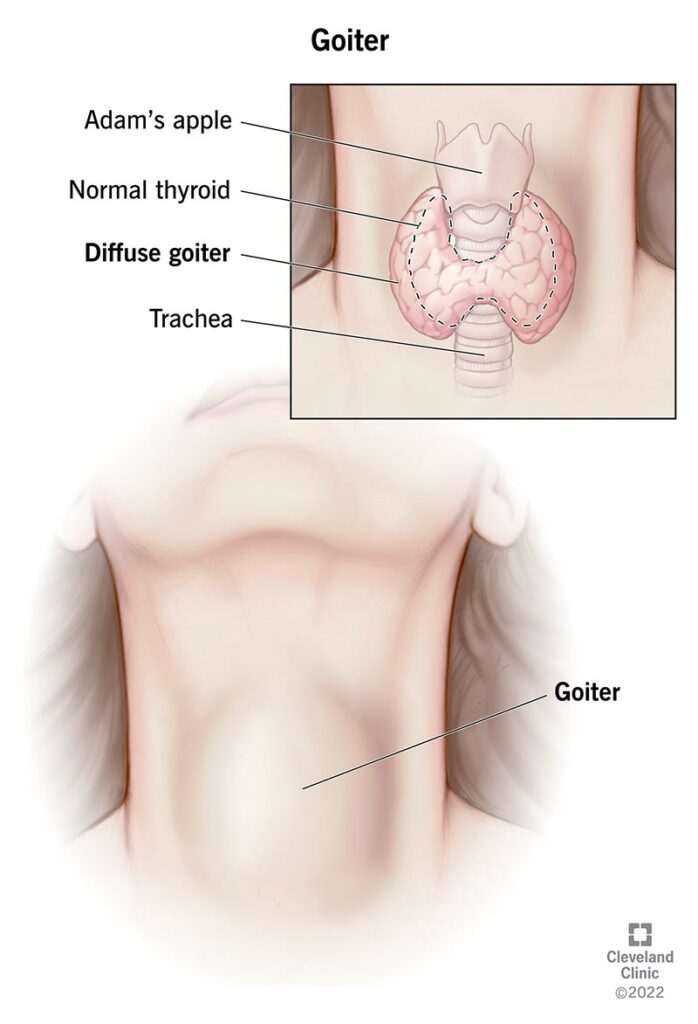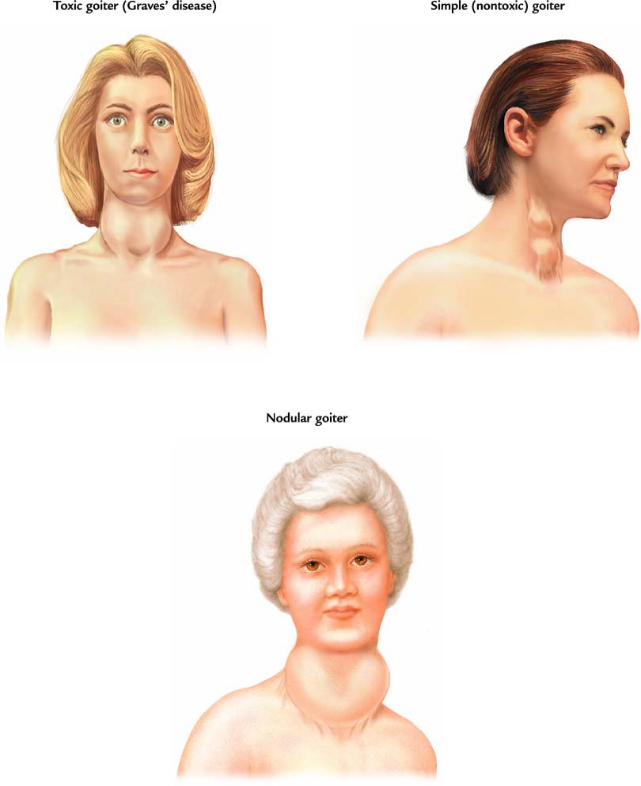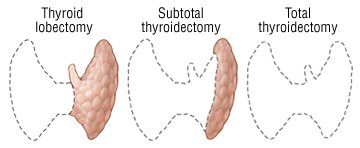Goiter
Goiter is a condition with an increase in the size of the thyroid gland located in the neck and is primarily caused by a deficiency of iodine. The obvious symptoms are abnormal swelling on the neck. There are various types, and one is the toxic multinodular goiter. Read More
Top Doctors For Goiter Treatments
Top Hospitals For Goiter Treatments
Goiter
Table of contents
What is a goiter?
Goiter is a condition with an increase in the size of the thyroid gland located in the neck and is primarily caused by a deficiency of iodine. The obvious symptoms are abnormal swelling on the neck. There are various types, and one is the toxic multinodular goiter. Two main hormones circulate in the bloodstream and help regulate body metabolism. They are triiodothyronine (T-3) and thyroxine (T-4). These two hormones are produced in the thyroid gland, a butterfly-shaped organ that lies in a person’s neck, just below the Adam Apple. They maintain metabolism- the rate at which the body uses fats and carbohydrates, help regulate body temperature, influence heart rate, and help to regulate protein production. In the body, the pituitary gland and hypothalamus control the production and release of T-3 and T-4.
In contrast, the thyroid gland regulates the production of hormones based on the amount of TSH it receives from the pituitary gland. An overproduction of T-3 and T-4 hormones could lead to the direct enlargement of the thyroid gland. In contrast, an underproduction may lead to prompting the TSH to overproduce the hormones, in turn resulting in the enlargement of the thyroid gland. This enlargement is called a goiter.

A goiter is an abnormal increase in the size of a person’s thyroid, a butterfly-shaped gland located at the neck.

What are the types of goiter?

There are different kinds of goiter, majorly due to their underlying causes. They include the following:
- Colloid Goiter (Endemic)
This type of goiter results from a lack of iodine. Most people with colloid goiter live in areas where iodine is in short supply, for instance, in inland and highland regions of the world.
- Nontoxic Goiter (Sporadic)
Nontoxic goiters may be caused by medications like lithium, which is often used to treat mood disorders such as bipolar disorder. They do not affect the production of thyroid hormone, and the thyroid still functions normally. The exact cause of nontoxic goiter is unknown.
- Toxic Multinodular Goiter
These goiters emerge when one or more small nodules are formed in the thyroid gland and produce their thyroid hormone, thus, resulting in hyperthyroidism. This result is usually an extension of simple goiter.
Causes
Goiter mainly results due to iodine insufficiency in the body. Iodine helps in the production of thyroid hormones. When the body lacks sufficient iodine, the pressure is mounted on the thyroid to make thyroid hormones, which causes the gland to enlarge.
Other causes of goiter may include hyperthyroidism, hypothyroidism, thyroiditis, thyroid cysts, thyroid cancer, and pregnancy.
- Iodine deficiency: Iodine is a vital element needed for producing thyroid hormones. It is often present in seawater and coastal soils. People living in inland or highland areas of the world are often deficient in iodine due to its limited supply in those regions, and as a result, they commonly develop goiters. Those who often take foods such as broccoli, cabbage, and cauliflower are also more prone to goiter because these foods are hormone-inhibiting foods that can affect the thyroid.
In countries where iodine is added to table salt and other foods, goiters may result from other causes other than lack of iodine.
- Hyperthyroidism: This is when the thyroid gland produces too much thyroid hormone, producing antibodies that blindly attack the thyroid gland, leading to the excess production of thyroxine. Hyperthyroidism can lead to the swelling of the thyroid, causing goiter.
- Hashimoto’s disease: This is also known as Graves’ disease. Hypothyroidism is a medical condition resulting from an underactive thyroid, where the thyroid produces insufficient hormone. This often triggers the pituitary gland to produce more thyroid-stimulating hormone, causing the enlargement of the thyroid gland as well as goiter.
- Multinodular goiter. This is a situation where both sides of the thyroid gland are enlarged. As a result, multiple nodules (solid or fluid-filled lumps) develop on them.
- Solitary thyroid nodules. This causes the enlargement of one side of the thyroid gland due to the development of a single nodule.
- Thyroid cancer. This is a cancerous growth on the thyroid that can cause swelling of the gland or otherwise goiter. A biopsy can be used to check for thyroid cancer. However, thyroid cancers are rare.
- Pregnancy. The thyroid gland in pregnant women could slightly enlarge due to the production of human chorionic gonadotropin (HCG) during pregnancy. This often causes goiter.
- Thyroiditis: Thyroiditis is a condition where the body produces excess or too little thyroxine. It often causes painful inflammation of the thyroid or painful goiter.
What are the risk factors associated with goiter?

Although goiters may affect anyone and may be present since birth, some people are more prone to the disorder than others. They include:
- Those living in areas where iodine-containing foods or supplements are in short supply
- Female gender: Statistics have shown that the incidence of goiter is high in women than in men.
- People above 40 years of age.
- Family history of goiter
- Pregnant women and women who have attained menopause.
- People who have been treated for heart or psychiatric conditions with certain medications containing amiodarone and lithium
- Persons exposed to radiation around the neck or chest either through radiation treatments or via a nuclear facility, test, or accident.
Symptoms
A person suffering from goiter may experience or exhibit the following symptoms:
- Swelling at the base neck, just below the Adam Apple.
- Discomfort in the throat
- Difficulty swallowing
- Coughing
- Hoarseness in voice (scratchy voice)
- Neck vein swelling
- Wheezing (due to squeezing of the windpipe)
- Difficulty breathing
How is goiter diagnosed?
Patients with swelling in the thyroid region of the neck are often suspected of having a goiter. Doctors check the swelling and run diagnostic tests to confirm the situation. Such diagnostics include:
- Physical examination; during the physical examination, the doctor will examine the thyroid gland and palpate (touch) the gland to look for enlargement or tenderness in the neck.
- Family history
- Blood Tests; are used to identify alterations in hormone levels and antibody production. These changes can significantly affect the thyroid hormones and hence the swelling of the glands.
- Radioactive iodine uptake; during this procedure, a small amount of radioactive iodine is given to the patient. It helps us to estimate the amount and rate at which the thyroid gland takes it. This test helps us to determine the function and cause of goiter.
- Thyroid function test; during this procedure, a blood sample is used to measure the amount of TSH, T3 and T4 levels produced by the thyroid gland. These tests help us to know whether the goiter is associated with an increase or decrease in thyroid function.
- Antibody tests; it helps us to detect antibody linked to autoimmune disorders such as Hashimoto’s thyroiditis or Grave’s disease.
- Ultrasonography; this scan helps us to detect the thyroid nodule and measure the size of the gland.
- Biopsy; during this examination, small samples of thyroid nodules are removed and examined at the laboratory to determine the nature and extent of the goiter.
How is goiter treated?
Based on the size and condition of the goiter, doctors determine the type of treatment to be administered to goiter patients. The treatment options could include one or more of the following.
- Medications
Medications can be used to treat hypothyroidism or hyperthyroidism, enabling the shrinking of the goiter. They are also widely used to reduce thyroiditis inflammation.
- Surgeries
A surgery known as thyroidectomy can be used to remove the abnormal thyroid gland, where the thyroid is resistant to medication or grows excessively.

- Radioactive Iodine (RAI)
This is used to treat toxic multinodular goiters. The patient ingests RAI orally to allow it to travel through the blood to the thyroid to destroy the overactive thyroid tissue.
- Home Care
This involves the patient taking recommended iodine supplements or iodine-containing food to either increase or decrease their iodine level. However, a small-sized goiter may require no treatment at all.
FAQ
Goiters are mostly caused by the over or under production of thyroid hormones, resulting from a lack of iodine in diets. However, they can also be due to other thyroidism, hypothyroidism, thyroiditis, thyroid cancer, etc.
Goiter symptoms include swelling at the base neck, discomfort in the throat, difficulty swallowing, coughing, and sometimes, difficulty breathing.
Goiter can be treated with the use of prescribed medication. Large and complex goiters can be cured through the removal of a part or all of the thyroid gland. Surgery is used to treat goiter resulting from thyroid cancer.
Simple goiters sometimes go away on their own. In such cases, the thyroid hormone may eventually be regulated on its own. However, some others will persist and increase in size over time.
Most of the goiters are painless. However, goiters due to thyroiditis and thyroid cancer can be painful.
A goiter resulting from a condition such as hypothyroidism can lead to more complex health problems, such as obesity, joint pain, heart diseases, and infertility.
Goiters are a relatively common condition, and the most common cause of goiters is iodine deficiency, which affects an estimated of about 2.2 billion population. The incidence of goiter is 5-20% population, with mild iodine deficiency. The prevalence increases to 20-30% with moderate iodine deficiency, and the incidence increases to greater than 30% with severe iodine deficiency [1].
Goiters caused due to iodine deficiency are the only goiter that can be prevented. Consuming a diet that includes fish, dairy products, and the right amount of iodized salt intake in the diet can prevent these types of goiters.
The prognosis of the goiters depends upon the type of goiter the patient is diagnosed with. Simple goiters have a very good prognosis. While the large or multinodular goiters have to be treated surgically, and the patient will be advised to take medications related to the thyroid gland lifelong. If the goiter is a sign of other thyroid conditions, such as Hashimoto’s thyroiditis or Grave’s disease, then the prognosis depends on the underlying cause of thyroid enlargement.
References
https://my.clevelandclinic.org/health/diseases/12625-goiter

























































